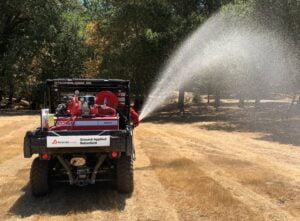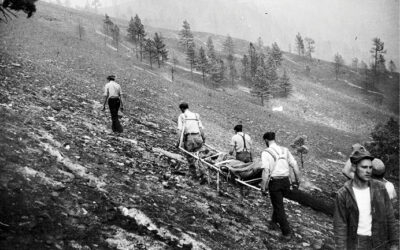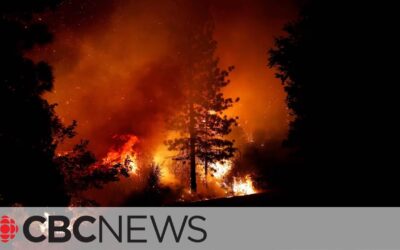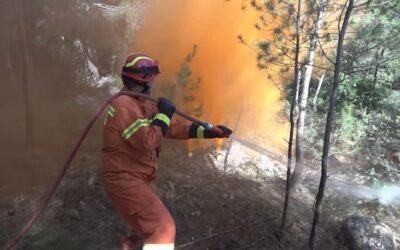Key Takeaways from the 2022 Wildfire Prevention Summit
By Wes Bolsen
The Western Fire Chiefs Association hosted its second annual Wildfire Prevention Summit earlier this year, and Perimeter Solutions proudly served as the Platinum Sponsor for the event, which examined the current wildfire situation and the critical need for those involved in fire management to transition from a focus primarily on fire suppression to one that includes proactive wildfire prevention and asset protection. More than two dozen presentations were delivered during the two-day virtual summit from fire safety industry experts, government agency officials, and representatives from the utility, transportation, and insurance industries. They shared critical insight on the use of preventative measures, and how phosphate-based fire retardants can be utilized from the ground to make wildfire prevention efforts more effective.
“The present and future conversations of wildfire prevention in terms of tangible results come from placing more emphasis on minimizing emissions from ever happening and maintaining control of fires both during daylight and at night. This can be done by early application of long-term retardant in high-risk areas and pushing the envelope of night operations,” said Steve Kaustinen, CEO of All Terrain Global in his presentation, “Being Part of the Solution: Preventing wildfire ignitions, Protecting Homes & Assets.”
 Kaustinen’s comments align with recommendations from the United Nations, following the recent release of their report, Spreading Like Wildfire: The Rising threat of Extraordinary Landscape Fires. Dr. Andrew Sullivan, with CSIRO, and one of the authors of the UN report discussed the findings during the summit. According to UN projections, the number of annual global wildfires is expected to increase 50% by the year 2100. In order to address the growing challenge presented by the proliferation of wildfire activity, the UN has recommended that regional governments start focusing more of their resources and financial investment in proactive wildfire prevention, rather than only on wildfire suppression. That makes fiscal sense as well, according to retired USDA Forest Service Chief Victoria Christiansen, who told attendees at the 2021 Wildfire Prevention that, “Research shows that every dollar spent on wildfire prevention saves $35 in suppression costs, and wildfire related losses.”
Kaustinen’s comments align with recommendations from the United Nations, following the recent release of their report, Spreading Like Wildfire: The Rising threat of Extraordinary Landscape Fires. Dr. Andrew Sullivan, with CSIRO, and one of the authors of the UN report discussed the findings during the summit. According to UN projections, the number of annual global wildfires is expected to increase 50% by the year 2100. In order to address the growing challenge presented by the proliferation of wildfire activity, the UN has recommended that regional governments start focusing more of their resources and financial investment in proactive wildfire prevention, rather than only on wildfire suppression. That makes fiscal sense as well, according to retired USDA Forest Service Chief Victoria Christiansen, who told attendees at the 2021 Wildfire Prevention that, “Research shows that every dollar spent on wildfire prevention saves $35 in suppression costs, and wildfire related losses.”
Retired fire Chief Dan Turner spent 37 years serving in the California Department of Forestry and Fire Protection. He currently serves as the Director of the Cal Poly Wildland Urban Interface Fire Institute and as the Executive Director of the San Luis Obispo Fire Safe Council. During his presentation at this year’s Wildfire Prevention Summit, he shared his first-hand experience working with PHOS-CHEK® FORTIFY®, a ground-based fire retardant produced by Perimeter Solutions. When applied on flammable vegetation and cellulosic surfaces, PHOS-CHEK FORTIFY can help render the material non-flammable and protect assets from wildfire for an extended period, until a significant rain event occurs.
“The [San Luis Obispo] Fire Safe Council working with CAL POLY and Perimeter Solutions, once they acquired the product, have done testing on the efficacy of this fire prevention retardant spray as a preventative tool. We have done some soil and other examinations on the environmental effects, and then we have applied it on different locations in the county to good effect. We are also working with the three major public utilities in California, on examining how we reduce ignitions and reduce damages to their infrastructure from fires started by a third party, and how do we reduce impacts to the public through public safety shutoffs by reducing the likelihood of fire burn from utility infrastructure,” says Turner.
Attendees at this year’s summit were motivated about the positive experiences Chief Turner and other speakers shared about using phosphate-based long-term retardant in proactive wildfire prevention efforts. Multiple new projects were launched this summer that illustrate the diverse ways PHOS-CHEK FORTIFY can be integrated into successful prevention and protection projects.
Following the event, Perimeter Solutions reached an agreement with San Diego County to provide PHOS-CHEK FORTIFY long-term fire retardant as part of the County’s newly approved Roadside Vegetation Management for Evacuation Preparedness Program. San Diego County maintains nearly 2,000 miles of roadway, much of which serves as key corridors for area evacuation and response to wildfires. A major utility also signed with Perimeter to treat high-risk areas around their gas pipelines to prevent ignitions.
The Colville Tribe in North Central Washington worked with Perimeter Solutions to treat the Tribe’s reservation with PHOS-CHEK FORTIFY, protecting the land and approximately 7,700 residents who live there. More tribes are expected to follow Colville’s lead, as a new grant established by the USDA has put aside $1 billion over the next five years for proactive wildfire efforts.
Railroad companies are starting to see the value of long-term fire retardant. This summer, two national rail lines plan to spray PHOS-CHEK FORTIFY from moving trains to protect high-risk areas from the sparks that occur during travel, and proactively protect wood bridge structures from ignition.
Since this year’s Summit, we have also witnessed a tremendous uptick in the number of homeowners who have had their property treated by professional service providers, including Allied Disaster Defense in West Covina, California.
“You’ve all seen PHOS-CHEK get dumped from airplanes. The beauty is that now it is available to us, and it can be applied from the ground – we can spray it ourselves on our own vegetation. We don’t have to wait for the planes to come. We can spray proactively before a wildfire hits,” said O.P. Almaraz, CEO of Allied Disaster Defense.
As pointed out by the UN and numerous other organizations, the number of wildfires is going to continue to rise in the coming years. The dangers they present will also be greater, as climate change creates larger, more intense fire seasons, and developers continue to build homes and businesses in the wildland urban interface. More fire management organizations are seeing how phosphate-based long-term fire retardants, like PHOS-CHEK FORTIFY, are effective in stopping wildfires before they start, and it will play a critical role in proactive wildfire prevention and protection efforts moving forward.
Wes Bolsen is Business Director, Wildfire Prevention and Protection at Perimeter Solutions




